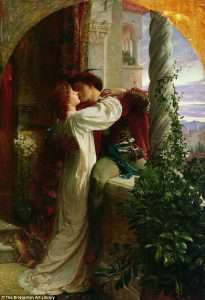by Hannah Gunson-McComb, dramaturg
Boy meets girl. Boy and girl fall in love. Boy and girl die less than three days later. Why does such a simple story spawn endless adaptations and parodies? How could such a story keep us entertained for so long? Lest you think this is a Shakespearean novelty, the story of “star-crossed lovers [who] take their life” has been one of humanity’s favorites. And it certainly wasn’t exclusive to Europe, either. Beyond the stage and song, artifacts and relics have been discovered that suggest Romeo and Juliet, as written by William Shakespeare, is but a distillation of true events and multi-cultural myths.
Perhaps the most romantic archeological find is that of a pair of Neolithic skeletons, buried together in an embrace, known as the “Lovers of Valdaro.” Found near Mantua, Italy (funnily enough, where Shakespeare’s Romeo is exiled). In case this discovery wasn’t intimate enough, it should be noted that double-entombment was rare. Rarer still is their “cuddling” position. While mothers from the same time period were often buried, cradling their child, romance is hard to come by in 6,000 year-old graveyards. This begs the question— what made their relationship so deserving of such treatment?

Skeletons not cool enough for you? How about some mountains? The Aztecs have you covered.
The Náhuas use a tragically romantic myth to explain why a mountain range just southeast of Mexico City looks like a sleeping woman. Before the Spaniards came to Tenochtitlán, the Aztec emperor of the time had a radiantly beautiful daughter and successor named Iztaccihuatl (also known as Itza). As the way these stories go, Itza fell in love with the captain of a fellow tribe, named Popocatépetl (or Popoca). When Popoca asked her father for Itza’s hand in marriage, the Emperor consented… if Popoca brought him the head of the warring tribe’s chief. Undaunted, Popoca went forth. Brazenly, a jealous rival spread rumours that Popoca had died. Itza, inconsolable, died of grief. The horrible irony of it is that Popoca came back shortly thereafter, successfully completing his bloody errand. Just as inconsolable by his love’s death, Popoca carried his would-have-been bride to the nearby mountain. There, he buried her and stabbed himself in the heart (not dissimilar to the end of Romeo and Juliet). While Itza sleeps peacefully as the snow-dusted “La Mujer Dormida,” Popoca violently rages as his volcanic reincarnation.

But the real seed of the story we know today, the scene of the crime as it were, is the Spanish lovers of 13th century Teruel Spain: Diego Marcilla and Isabel Seguras. Diego was thrust into poverty at the most inconvenient time— right when he was about to propose to his childhood friend, Isabel. Her father, the richest man in town, adamantly denied the union. Diego bargained with Isabel’s father and they came to an agreement: he would be given five years to seek his fortune. Should he come back financially stable, he could marry Isabel. No one saw or heard of him for the next five years. Rather than be patient, Isabel’s father married her to another man on the very day Diego was supposed to come back. Which made things awkward when Diego, extremely successful in his endeavors, showed up to Casa de Seguras, moments after the wedding ceremony was completed. At Isabel’s feet, Diego begged her to marry him, but her hands were tied by marital contract. In lieu of marriage, he then pled for a kiss, but Isabel denied him again. Diego was so overcome with grief that he died right then and there. Lest we think Isabel was cold-hearted, when she showed up at the church for Diego’s funeral, she wore her wedding dress. She walked to where his body lay at the front of the church, gave him that kiss he so desperately sought… and promptly died, falling across his body. Their stunning (read: dramatic) displays of love was so moving to the people or Teruel that they demanded riotously that they be entombed together. You can visit the Mausoleum of the Iglesia de San Pedro in Teruel and see the marble-carved caskets that memorialize their love.

Diego and Isabel’s story spread quickly throughout Western Europe, and many a writer published their own fictionalized versions. It’s thanks to a 15th-century writer, Luigi da Porto, that we’ve got the Romeo and Juliet of today. In his book Historia Novellamente Ritrovata di due Nobili Amanti (a Story Newly Found of Two Noble Lovers), he set many of the details that Shakespeare would later use: the story takes place in Verona, the lovers’ names are Romeo and Giulietta (close enough), the families are Montecchi and Capelletti (also close enough), the characters of Paris and Friar Laurence, and the lovers’ suicide. The next author to adapt this story, Matteo Bandello, included the Capulet’s party and the character of Mercutio (created with the same “audacious” personality we see today). The French put their two cents in, and included Juliet’s feelings about Tybalt and Lord Capulet allowing Romeo to stay at the party. All of this was collected and included in an anthology of stories. It was extremely popular, and it’s most likely that Shakespeare grew up, knowing this story.
The funny thing is right before Shakespeare, a poet named Arthur Brooke also wrote the same story as a poem, but to him, it was a cautionary tale. Brooke had some… critical feelings about Romeo and Juliet. He despised them because they “thrill[ed] themselves to un-honest desire; neglecting the authority and advice of friends… [and] abuse[d] the honorable name of lawful marriage to cloak the shame of stolen contracts.” His feelings are certainly prevalent in many academic circles today. Even as early as high school, readers are skeptical of Romeo and Juliet’s “love,” and often interpret their affections as “lust.” And if we take a look further into the history of Shakespeare’s play version, it seems like the Bard himself wasn’t out to write a powerful love story— he was writing raunchy fan fiction.

Shakespeare jam-packed his play with many heightened details that convey Romeo and Juliet’s affections as extremely dramatic. Firstly, instead of the story taking place over several months, it only spans three days. Upon contact, they instantly fall in love. Anyone who’s ever been in love recognizes the sheer illogicality of such an event, so their entire relationship becomes comprised of an intensity that lacks the depth of time-tried and mature love. For emphasis, Shakespeare writes a line for Juliet: “Gallop apace ye fiery-footed steeds,” and it was so bawdy and indecent for that time (and for a long time thereafter) that actresses refused to perform it. While Shakespeare’s plays are rife with dirty and colorful jokes to please the groundlings, that specific line crosses a social boundary. While you could argue that such sudden, ardent passion is a common convention of big-R-Romantic, courtly love (as exemplified in Dante’s or Petrarch’s poetry), that amorous convention was never acted upon beyond writing eloquent letters… and famously, Romeo and Juliet consummate their marriage. Albeit off-stage, the not-so-veiled implications are titillatingly risqué. Up to Shakespeare, the lovers of this story remained chaste. Even though Romeo and Juliet are “covered” by their marriage, as Arthur Brooke so loquaciously criticised, it was a sham and an insult to what marriage should be/have been.
We can view the distillation of the Romeo and Juliet story throughout history cynically, perhaps as Arthur Brooke would have. We can enjoy the comedy that its spawned, such as Nature Theatre of Oklahoma’s production, wherein they interviewed hundreds of people about what they remembered from the famous story and crafted the entirety of the script from those interviews… which were often lacking in details and accuracy. We can recognize that Shakespeare’s Romeo and Juliet has so much to offer in terms of themes that we can use the lovers as a motif rather than the main subject to highlight a different theme than the classic “fate,” such as in West Side Story. Or you can throw all of this aside and return to the general stasis: that Romeo and Juliet is the Greatest Love Story Of All Time™, they were in Love™, and it’s all Fate’s™ fault.
No matter your personal opinion, none of us can escape relentless adapting. We certainly can’t escape reading it out-loud as a class or watching the 1968 movie in high school. Even without knowing the extended history of Romeo and Juliet, I can accept that the exciting drama of the forbidden-love story makes for risk-free entertainment. There is something about the combination of two incongruous elements (death and love) that makes for a powerful story, whether or not you agree with it.
But for the life of me, I cannot understand why Romeo and Juliet is indelibly etched into educational curriculums when Macbeth is just as viable an option.



